Thoroughly analyzing TS Inter 2nd Year Physics Model Papers and TS Inter 2nd Year Physics Question Paper May 2019 helps students identify their strengths and weaknesses.
TS Inter 2nd Year Physics Question Paper May 2019
Time: 3 Hours
Maximum Marks: 60
Section – A (10 × 2 = 20)
Note :
- Answer all questions.
- Each question carries two marks.
- All are Very Short Answer Type Questions.
Question 1.
What is the importance of Oersted’s Experiment ?
Answer:
Importance of oersted’s experiment is every current carrying conductor produces a magnetic field around it and which is perpendicular to carrying conductor.
Question 2.
The focal length of a concave lens is 30 cm. Where should an object be placed so that its image is 1/1010 of its size ?
Answer:

Question 3.
Magnetic lines form continuous closed loops. Why ?
Answer:
Magnetic lines of force always start from north pole and forming curved path, enther south pole and travel to north pole inside the magnet. Thus lines of force are forming closed loops.
![]()
Question 4.
Define Curie temperature.
Answer:
The temperature of transition from ferromagnetic to paramag¬netism is called the curie temprature TC.
Question 5.
What is meant by wattjess component of current ?
Answer:
If the voltage and current differ in phase by \(\frac{\pi}{2}\), then power factor, cos Φ = cos 90° = 0. In this case, the current has no power. Such a current is called wattless current, since this current does not perform any work, this current may also be called idle current. Such a current flows only in purely inductive or in purely capacitive circuits.
Question 6.
Give two uses of infrared rays.
Answer:
a) Infrared rays are used in industry, medicine and astronomy.
b) Infrared radiation plays an important role in maintaining the earth warm.
c) These are useful for or haze photography.
d) Infrared detectors are used in earth satellites.
Question 7.
What is “photoelectric effect” ?
Answer:
When light of sufficient energy is incident on the photometal surface, electrons are emitted. This phenomenon is called photometal effect.
Question 8.
What is the deBroglie’s wavelength of a ball of mass 0.12 kg moving with a speed of 20 ms-1 ?
Answer:
Given, m = 0.12 kg; V = 20 m/s; h = 6.63 × 10-34j-s;
λ = \(\frac{\mathrm{h}}{\mathrm{mv}}\) = \(\frac{6.63 \times 10^{-34}}{0.12 \times 20}\) = \(\frac{6.63 \times 10^{-34}}{2.4}\)
∴ λ = 2.762 × 10-34m = 276 × 10-21A°.
The wave length of ball is very very small. Hence, its motion can be observed.
Question 9.
What is an n-type semiconductor ? What are the majority and minority charge carriers in it ?
Answer:
If a pertavalent impurity is added to pure tetravalent semiconductor, it is called n-type semiconductor. In n-type semiconductor majority charge carriers are electrons and minority charge carriers are holes.
Question 10.
What is sky wave propagation ?
Answer:
In the frequency range from a few MHz upto 30 MHz, long distance comrhunication can be achieved by ionospheric reflection of radiowaves back towards the Earth. This mode of propagation is called sky wave propagation.
Section – B (6 × 4 = 24)
Note :
- Answer any six of the following questions.
- Each question carries four marks.
- All are Short Answer Type Questions.
Question 11.
Why does a setting sun appearred ?
Answer:
As sunlight travels through the Earth atmosphere, gets scattered by the large number of molecules present. This scattering of sun light is responsible for the colour of the sky during sunrise and sunset etc.
The light of shorter wave length is scattered much more than light of large wave length. Scattering α \(\frac{1}{\lambda^4}\).
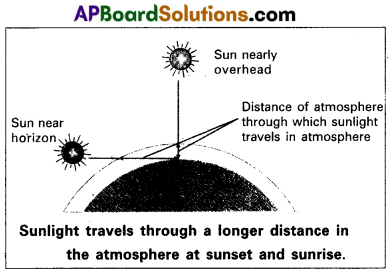
Most of blue is scattered, hence the bluing colour of sky predominates.
At sunset (or) sunrise, sun rays must pass through a large atmospheric distance. More of the blue colour which is least scattered appears to ‘come from Sun. Hence it appears red.
![]()
Question 12.
Explain Doppler effect in light. Distinguish between red shift and blue shift.
Answer:
Doppler effect in light: The change in the apparent frequency of light, due to relative motion between source of light and observer. This phenomenon is called Doppler effect.
The apparent frequency of light increases when the distance between observer and source of light is decreasing and the apparent frequency of light decreases. If the distance between source of light and observer increasing.
Doppler shift can be expressed as, \(\frac{\Delta V}{V}=\frac{-V \text { radical }}{C}\)
Applications of Doppler effect in light :
- It is used in measuring the speed of star and speed of galaxies.
- Measuring the speed of rotation of the sand.
Red shift: The apparent increase in wavelength in the middle of the visible region of the spectrum moves towards the red end of the spectrum is called red shift.
Blue shift : When waves are received from a source moving towards the observer, there is an apparent decrease in wavelength, this is called blue shift.
Question 13.
Derive an expression for the (intensity of the) electric field at a point on the axial line of an electric dipole.
Answer:
Intensity of the electric field at a point on the axial line of an electric dipole : Let us consider an electric dipole as a pair of equal and opposite point charges +q and – q, separated by a distance ‘2a’ its dipole moment is p.
Lets the point ‘p’ be the distance ‘r’ from the centre of the dipole on the side of the charge ‘q’.
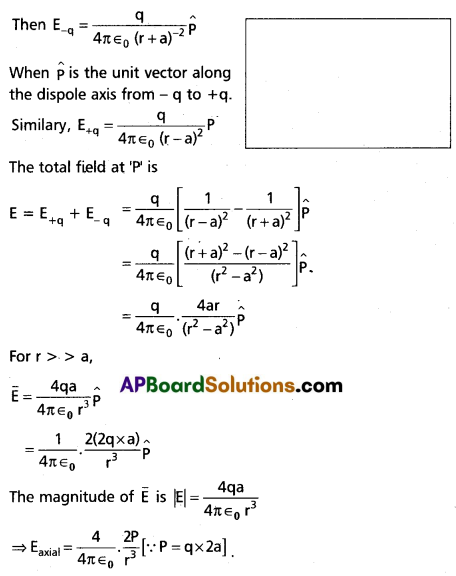
Question 14.
Derive the formula for equivalent capacitance in series combi¬nation of capacitors.
Answer:
Series Combination : If a number of capacitors are connected end to end between the field points then such combination is called series.
In this combination :
- Charge on each capacitor is equal.
- P.D’s across capacitor is not equal.
Consider three capapitor’s of capacitance C1, C2 and C3 are connected in series across a battery of P.D ‘V’ as shown in figure.
Let ‘Q’ be the charge on each capacitor.
Let V1, V2 and V3 be P.D’s of three capacitor then
V = V1 + V2 + V3 …………… (1)
P.D across Ist condenser V1 = \(\frac{\mathrm{Q}}{\mathrm{C}_1}\)
P.D across IInd condenser V2 = \(\frac{\mathrm{Q}}{\mathrm{C}_2}\)
P.D across IIIrd condenser V3 =\(\frac{\mathrm{Q}}{\mathrm{C}_3}\)
∴ From the equation (1), V = V1 + V2 + V3
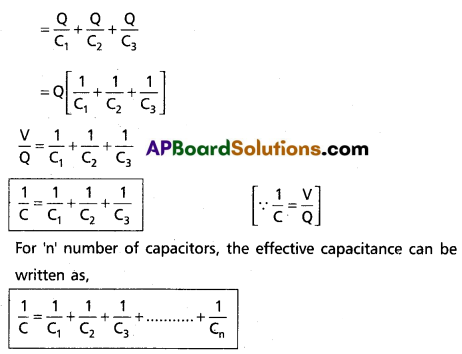
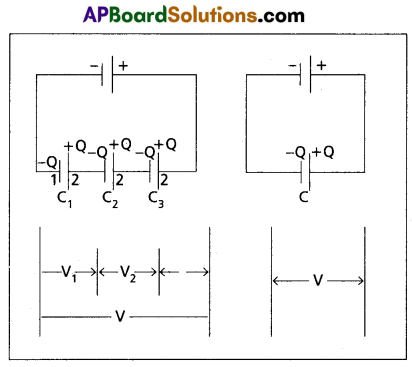
![]()
Question 15.
Derive an expression for the magnetic dipole moment of a revolving electron.
Answer:
Consider an electron revolving in a circular orbit of radius r with speed v and travelled by electron to complete one revolution = 2πr.
No. of revolution in one second (V) = \(\frac{V}{2 \pi r}\)
The electric current (i) = \(\frac{\text { charge }}{\text { time }}\) = charge × frequency
i = e × \(\frac{V}{2 \pi r}\)
∴ Magnetic dipole moment (M) = iA (∵ N = 1)
M = \(\frac{\mathrm{eV}}{2 \pi r}\) × πr2 (∵ A = πr2)
M = \(\frac{\mathrm{eVr}}{2}\)
Question 16.
Current in a circuit falls from 5.0 A to 0A in 0.1s. If an average emf. of 200 V is induced, give an estimate of the self induc-tance of the circuit.
Answer:
Change in current, dl = 5 – 0 = 5A
Time taken in current change, dt = 0.1 sec.
Induced average emf, eavg = 200V
⇒ e = L.\(\frac{\mathrm{dl}}{\mathrm{dt}}\)
⇒ 200 = L \(\frac{5}{0.1}\)
⇒ L = \(\frac{200}{500}\) = 4H
Question 17.
Write a short note on deBroglie’s explanation of Bohr’s Second Postulate of quantization.
Answer:
De-Broglie explanation of Bohr’s second postulate of quantization :

A standing wave is shown on a circular orbit ware four deBroglie wavelengths fit into the circumference of the orbit.
i) The electron in its circular orbit must be seen on a particular wave.
ii) Particle wave too can lead to standing waves under resonant conditions.
iii) When string is plucked, a vast number of wavelengths are excited. However only those wavelengths survive, which have nodes at the ends and from the standing waves when the total distance travelled by a wave down the string and back is one wavelength, two wavelength or any integral multiple number of wavelengths.
iv) For an electron moving in nth circular orbit or radius rn, the total distance is circumference of the orbit.
Thus 2πrn = nλ, n = 1,2, 3, ………..
The de-Brdglie wavelength is λ = \(\frac{h}{\mathrm{P}}\)
= \(\frac{\mathrm{h}}{\mathrm{mVn}}\)
⇒ 2πrn = \(\frac{n h}{m V n}\)
mVnrn = \(\frac{n h}{2 \pi}\) = Ln
This is quantum condition for the angular momentum. Thus de-Broglie hypothesis for Bohr’s second postulate for the quantisation of angular momentum of orbiting electron.
Question 18.
Explain the working of LED. What are its advantages over con-ventional incandescent low power lamps ?
Answer:
Light Emitting Diode : It is a photoelectranic device which converts electrical energy into light energy.
It is a heavily doped P-n junction diode which under forward bias emits spontaneous radiation. The diode is covered with a transparent cover. So that the emitted light may’be come out.
Working : When P-n junction diode is forward biased, the movement of majority charge carriers takes place across the junction. The electrons move from n-side to p-side through the junction and holes move from p-side to n-side. As a result on it, concentration of majority carriers increases rapidly at the junction. When there is no bias across the junction, therefore there are excess minority carriers on either side of the junction, which recombine with majority carriers near the junction. On recombination of electrons and hole, the energy is given out in the form of heat and light.
Advantages :
- LED is cheap and easy to handle.
- LED has less power and low operational voltage.
- LED has fast action and requires no warm up time.
- LED can be used in burglar alarm system.
![]()
Section – C (2 × 8 = 16)
Note :
- Answer any two of the following questions.
- Each question carries eight marks.
- All are Long Answer Type Questions.
Question 19.
a) How are stationary waves formed in closed pipes ? Explain various modes of vibrations and obtain relations for their frequencies.
Answer:
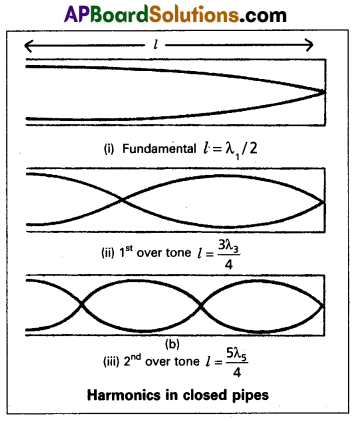
A pipe which is Closed at one end and opened at the other end is called closed pipe. When a sound wave is sent through a closed pipe, which gets reflected at the closed end of the pipe. Then incident and reflected waves are in same frequency travelling in the opposite directions are superimposed, stationary waves are formed.
To form the stationary wave in closed pipe, which has atleast a node at closed end and antinode at open end of the pipe, it is known as first harmonic in closed pipe. Then length of the pipe (l) is equal to one fourth of the wave length.
∴ l = \(\frac{\lambda_1}{4}\) ⇒ λ1 = 4l
If ‘V1‘ is fundamental frequency then
V1 = \(\frac{V}{\lambda_1}\) where ‘V’ is velocity of sound in air
V1 = \(\frac{\mathrm{V}}{4 l}\) …….. (1)
To form the next harmonic in closed pipe, two nodes and two antinodes should be formed. So that there is possible to form third harmonic in closed pipe, since one more node and antinode should be included.
Then length of the pipd is equal to 3/4 of the wavelength.
∴ l = \(\frac{3 \lambda_3}{4}\) where ‘λ3‘ is wavelength of third harmonic.
λ3 = \(\frac{4 l}{3}\)
If ‘V3‘ is third harmonic frequency (first overtone)
∴ V3 = \(\frac{\mathrm{V}}{\lambda_3}=\frac{3 \mathrm{~V}}{4 l}\)
V3 = 3V1 ………. (2)
Similarly the next overtone in the close pipe is only fifth harmonic it will have three nodes and 3 antinodes between the closed end and open end.
Then length of the pipe is equal to 5/4 of wave length (λ5).
∴ l = \(\frac{5 l_5}{4}\) where ‘λ5‘ is wavelength of fifth harmonic.
λ5 = \(\frac{4 l}{5}\)
If ‘V5‘ is frequency of fifth harmonic (second overtone)
V5 = \(\frac{\mathrm{v}}{\lambda_5}\) = 5V/4l
V5 = 5V1
∴ The frequencies of higher harmonics can be determined by using the same procedure.
Therefore from the eq(l), (2) and (3) only odd harmonics are formed.
Therefore the ratio of the frequencies of harmonics in closed pipe can be written.
V1 : V3 : V5 = V : 3V : 5V
V1 : V3 : V5 = 1 : 3 : 5
b) A closed organ pipe 70 cm long is sounded. If the velocity of sound is 331 m/sec. What is the fundamental frequency of vibration of the air column ?
Solution:
Length, l = 70 cm = 70 × 10-2 m
v = 331 m/s
v = \(\frac{v}{4 l}\) = \(\frac{331}{4 \times 70 \times 10^{-2}}\) = 118.2 Hz.
Question 20.
a) State the working principle of potentiometer. Explain with the help of a circuit diagram, how the emf of two primary cells are compared by using the potentiometer.
Answer:
Working principle of potentiometer : The potentiometer difference across a length of the potentinat to its length (or) when a steady current is passed through a uniform wire, potental drop per unit length or potential gradient is constant.
i.e., ε α l ⇒ ε = Φl where Φ is potential gradient.
Comparing the emf of two cells ε1 and ε2:
- To compare the emf of two cells of emf ε1 and ε2 with potentiometer is shown in diagram.
- The point marked 1,2, 3 form a two way key,
- Consider first a position of the key where 1 and 3 are connec¬ted so that the galvanometer is connected to ε1.
- The Jockey is moved along the wire till at point N1 at a distance l1 from A, there is no deflection in the galvanometer.
Then ε1 α l1 ⇒ ε1 = Φl1 …………. (1) - Similarly, if another emf ε2 is balanced against
l2(AN2)
Then ε2 α l2 ⇒ ε2 = Φl2 - \(\frac{(1)}{(2)}\) ⇒ \(\frac{\varepsilon_1}{\varepsilon_2}=\frac{l_1}{l_2}\)
b) A potentiometer wire is 5m long and a potential difference of 6V is maintained between its ends. Find the emf of a cell which balances against a length of 180 cm of the potentiometer wire.
Answer:
Length of potentiometer wire l = 5m
Potential difference, v = 6 volts
Potential gradient, Φ = \(\frac{\mathrm{V}}{\mathrm{L}} \) = \(\frac{6}{5}\) = 1.2v/m
Balancing length (l) = 180 cm = 1.8m
Emf of the cell = Φl = 1.2 × 1.8 = 2.16V
![]()
Question 21.
a) Explain the principle £nd working of a nuclear reactor with the help of a labelled diagram.
Answer:
Principle : A nuclear reactor works on the principle of achieving controlled chain reaction in natural uranium 238U enriched with 235U, consequently generating large amounts of heat.
A nuclear reactor consists of :
1) Fuel
2) Moderator
3) Control rods
4) Radiation shielding
5) Coolant
1) Fuel and Clad : In reactor the nuclear fuel is fabricated in the form of thin and long cylindrical rods. These group of rods treated as a fuel assembly. These rods are surrounded by coolant, which is used to transfer of hear produced in them. A part of of the nuclear reactor which used to store the nuclear fuel is called the core of the reactor. Natural uranium, enriched uranium, plutonium and uranium-233 are used as nude fuels.
2) Moderator : The average energy of neutrons relased in fission process is 2meV. They are used to slow down the velocity of neutrons. Heavy water or graphite are used as moderating materials in reactor.
3) Control rods : These are used to control the fission rate in reactor by absorbing the neutrons. Suitable shielding such as steel, lead, concrete etc., are provided around the reactor to absorb and reduce intensity of radiations to such low levels that do not harm the operating personnel.
4) Coolant: The heat generated in fuel elements is removed’ by using a suitable coolant to flow around them. The coolants used are water at high pressures, molten sodium etc.
Working : Uranium fuel rods are placed in the aluminium cylinders. The graphite moderator is placed in between the fuel cylinders to control the holes of graphite block. When a few 235U nuclei undergo fission fast neutrons are liberated. These neutrons pass through the surrounding graphite moderator aud loose their energy to become thermal neutrons. These thermal neutrons are captured by 235U. The heat generated here is used for heating suitable coolants which in turn heat water and produce steam. This stem is made to rotate steam turbine and there by drive a generator of production for electric power.
b) Calculate the energy equivalent of 1 gm of substance.
Answer:
Energy E = mc2
= 10-3 × (3 × 108)2
= 10-3 × 9 × 1016
E = 10-3 × 1013J.